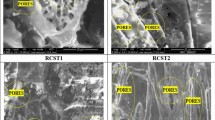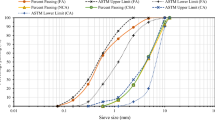Abstract
Coconut shell (CS) aggregates are naturally porous, allowing them to absorb up to 20–24%. However, treating the CS may decrease its porosity, potentially leading to a reduced penetrability of chloride ions in the resulting concrete. Six treatments were administered to the CS to explore this possibility, and the resulting concrete made from the treated CS was assessed for chloride ion penetrability. The treatments included sago flour (SF), slaked lime (SL), acetic acid (AA), ferrous sulfate (FS), polyvinyl alcohol (PVA), and corn flour (CF). The study used a salt ponding test to investigate the chloride ion penetrability of concrete made with treated CS as coarse aggregate in comparison with untreated CS aggregate used in concrete. The findings indicate that the treatments applied to the CS enhance its potential use as a coarse aggregate in concrete production for reducing chloride ion penetration. In this research endeavor, an artificial neural network (ANN) model was utilized to anticipate the compressive strength of untreated and treated coconut shell concrete. The findings yielded by the ANN model demonstrated remarkable precision, as evidenced by an R2 value of no less than 0.99, in projecting the compressive strength of the two concrete types.













Similar content being viewed by others
Data availability
The datasets generated and analyzed during the current study are available from the corresponding author on reasonable request.
References
ACI 318. (2022). Building code requirements for reinforced concrete, ACI manual of concrete practice. Detroit: American Concrete Institute.
AASHTO (T 259-80). (2019). Standard method of test for resistance of concrete to chloride ion penetration. American Association of State Highway and Transportation Officials.
Al-Negheimish, A. I., & Al-Zaid, R. Z. (2004). Effect of manufacturing process and rusting on the bond behavior of deformed bars in concrete. Cement and Concrete Composites, 26(6), 735–742.
AS 3600. (1988). Concrete structures. Sydney: Standards Association of Australia.
BS 8110, Structural use of concrete Part 1. (1997). Code of practice for design and construction. London: British Standard Institution.
Cabrera, J. G. (1996). Deterioration of concrete due to reinforcement steel corrosion. Cement and Concrete Composites, 18(1), 47–59.
Fang, C., Lundgren, K., Chen, L., & Zhu, C. (2004). Corrosion influence on bond in reinforced concrete. Cement and Concrete Research, 34(11), 2159–2167.
Glass, G. K., & Buenfeld, N. R. (2000). Chloride-induced corrosion of steel in concrete. Progress in Structural Engineering and Materials, 2, 448–458.
Gunasekaran, K., & Annadurai, R. (2017). Coconut Shell as an Aggregate in Concrete. Lambert Academic Publishing.
Gunasekaran, K., Kumar, P. S., & Lakshmipathy, M. (2010). Compatibility studies on the coconut shell cements composites. Indian Journal Indian Concrete Institute, 11(1), 27–31.
Gunasekaran, K., Kumar, P. S., & Lakshmipathy, M. (2011). Mechanical and bond properties of coconut shell concrete. Construction and Building Materials, 25(1), 92–98.
Gunasekaran, K., Annadurai, R., & Kumar, P. S. (2015). A study on some durability properties of coconut shell aggregate concrete. Materials and Structures, 48, 1253–1264.
Hossain, K. M. A. (2004). Properties of volcanic pumice based cement and LWC. Cement and Concrete Research, 34(2), 283–291.
https://www.google.com/search?q=coconut+shell+product&oq=coconut+shell+&aqs=chrome.4.69i57j017.6698j0j8&sourceid=chrome&ie=UTF-8. (2020). Retrieved 01 July 2020.
IS: 456–2000. (2021). Indian Standard: Plain and reinforced concrete-code of practice.
Jayaprithika, A., & Sekar, S. K. (2016). Stress-strain characteristics and flexural behaviour of reinforced eco-friendly coconut shell concrete. Construction and Building Materials, 117, 244–250.
Kaveh, A., Elmieh, R., & Servati, H. (2001a). Prediction of momentrotation characteristic for semi-rigid connections using BP neural networks. [Online]. Available: https://www.sid.ir/en/journal/viewPaper.aspx?ID=40312. Accessed 12 Jan 2023.
Kaveh, A., Servati, H., & Fazel, D. (2001b). Prediction of momentrotation characteristic for saddle-like connections using FEM and BP neural networks. [Online]. Available: https://www.sid.ir/en/journal/viewPaper.aspx?ID=39305. Accessed 12 Jan 2023.
Kaveh, A., & Iranmanesh, A. (1998). Comparative study of backpropagation and improved counterpropagation neural nets in structural analysis and optimization. International Journal of Space Structures, 13(4), 177–185. https://doi.org/10.1177/026635119801300401
Kaveh, A., & Khavaninzadeh, N. (2023). Efficient training of two ANNs using four meta-heuistic algorithms for predicting the FRP strength. In Structures, 52, 256–272.
Kaveh, A., & Servati, H. (2001). Design of double layer grids using backpropagation neural networks. Computers & Structures, 79(17), 1561–1568. https://doi.org/10.1016/S0045-7949(01)00034-7
Mannan, M. A., Alexander, J., Ganapathy, C., & Teo, D. C. L. (2006). Quality improvement of oil palm shell (OPS) as coarse aggregate in lightweight concrete. Building and Environment, 41, 1239–1242.
Maryono Rahmawati, S. (2013). Preparation and quality analysis of coconut shell charcoal briquette observed by starch concentration. Journal of Chemistry, 14, 74–83.
Nakkeeran, G., & Krishnaraj, L. (2023). Prediction of cement mortar strength by replacement of hydrated lime using RSM and ANN. Asian Journal of Civil Engineering, 24, 1401–1410. https://doi.org/10.1007/s42107-023-00577-6
Nolan, E., Basheer, P. A. M., & Long, A. E. (1995). Effects of three durability enhancing products on some physical properties of near surface concrete. Construction and Building Materials, 9(5), 267–272.
Orlova, N. V., Westall, J. C., Rehani, M., & Koretsky, M. D. (1999). The study of chloride ion migration in reinforced concrete under cathodic protection. Oregon State University, Final report for Oregon Department of Transportation Salem, Oregon 97310.
Prakash Chandar, S., Gunasekaran, K., Satyanarayanan, K. S., & Annadurai, R. (2018). Study on some durability properties of coconut shell concrete with quarry dust. European Journal of Environmental and Civil Engineering. https://doi.org/10.1080/19648189.2017.1418435
Sekar, A., & Kandasamy, G. (2019). Study on durability properties of coconut shell concrete with coconut fiber. Buildings, 09(107), 1–13.
Smith, B. G. (2001). Durability of silica fume concrete exposed to chloride in hot climates. Journal of Materials in Civil Engineering, 13(1), 41–48.
St John, D. A., Poole, A. B., & Sims, I. (1998). Concrete petrography-a handbook of investigative techniques. Elsevier.
Sudding, J. (2016). The process of coconut shell based on pyrolysis technology to produce renewable energy sources. Proceedings of ICMSTEA 2016: International Conference on Mathematics, Science, Technology, Education and their applications, Makassar, Indonesia, 3–4 October (pp. 498–510).
Traore, Y. B., Messan, A., Hannawi, K., Gerard, J., Prince, W., & Tsobnang, F. (2018). Effect of oil palm shell treatment on lightweight concrete’s physical and mechanical properties. Construction and Building Materials, 161, 452–460.
http://www.flinnsci/api/library/Download/8dcefc2345ef4072a3d0082316723ad8. (2016). Retrieved 01 Feb 2020.
Yousif, E. I., Gadallah, M. G. E., & Afaf Sorour, M. (2012). Physico-Chemical and rheological properties of modified corn starches and its effect on noodle quality. Annals of Agricultural Science, 57(1), 19–27.
Funding
This research received no external funding.
Author information
Authors and Affiliations
Contributions
T. Thilagashanthi: Investigation, Data curation, Formal analysis, Software, Writing – original draft. K. Gunasekaran: Conceptualization, Methodology, Supervision, Writing – review & editing. K.S. Satyanarayanan: Conceptualization, Supervision, Validation, Visualization.
Corresponding author
Ethics declarations
Conflict of interest
The authors declare no conflict of interest.
Additional information
Publisher's Note
Springer Nature remains neutral with regard to jurisdictional claims in published maps and institutional affiliations.
Rights and permissions
Springer Nature or its licensor (e.g. a society or other partner) holds exclusive rights to this article under a publishing agreement with the author(s) or other rightsholder(s); author self-archiving of the accepted manuscript version of this article is solely governed by the terms of such publishing agreement and applicable law.
About this article
Cite this article
Thilagashanthi, T., Gunasekaran, K. & Satyanarayanan, K.S. Assessment of chloride ion penetrability and compressive strength prediction in concrete with treated coconut shell aggregates using experimental and ANN approaches. Asian J Civ Eng 24, 3641–3652 (2023). https://doi.org/10.1007/s42107-023-00740-z
Received:
Accepted:
Published:
Issue Date:
DOI: https://doi.org/10.1007/s42107-023-00740-z




